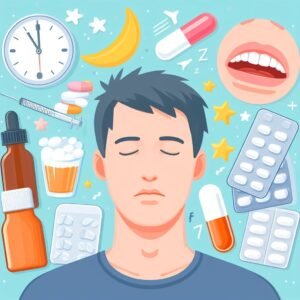Sleep bruxism is a common condition characterized by the clenching or grinding of teeth during sleep. This can lead to potential temporomandibular joint (TMJ) pain.
This article aims to examine the risk factors and medications associated with sleep bruxism, as well as its impact on TMJ health.
Several medications have been linked to bruxism, including antidepressants, anticonvulsants, ADHD medications, and Parkinson’s disease medications.
It is crucial for healthcare providers to be vigilant in monitoring and assessing bruxism symptoms in patients taking these medications. They should also discuss management strategies to alleviate discomfort and minimize complications associated with this condition.

Key Takeaways
- Bruxism can occur during sleep (sleep bruxism) or during wakefulness (awake bruxism) and is characterized by clenching or grinding of the teeth and/or by bracing or thrusting of the mandible.
- Antidepressants, particularly SSRIs and SNRIs, are strongly associated with bruxism, and approximately 11% of Americans take antidepressants.
- Certain anticonvulsant medications used to treat conditions such as epilepsy can induce or attenuate bruxism, highlighting the importance of regular monitoring and assessment of bruxism symptoms.
- Phenethylamines, which are medications used to treat ADHD, have been associated with bruxism, emphasizing the need for close monitoring of bruxism symptoms when prescribing these medications.
Definition and Types of Bruxism
Sleep bruxism, characterized by repetitive jaw-muscle activity during sleep, is a relatively common condition that affects individuals with varying frequencies.
It is a form of bruxism, which is defined as the clenching or grinding of teeth and/or bracing or thrusting of the mandible. Bruxism can occur during both sleep and wakefulness, but sleep bruxism is specifically indicated by the repetitive jaw-muscle activity during sleep.
Awake bruxism, on the other hand, is indicated by the repetitive jaw-muscle activity during wakefulness.
Sleep bruxism can lead to potential temporomandibular joint (TMJ) pain.
It is important to understand the different types of bruxism and their characteristics in order to accurately diagnose and treat the condition.
Antidepressants and Bruxism
The association between bruxism and medications extends to antidepressants, which are commonly prescribed drugs in the country. Most cases of medication-related bruxism are caused by antidepressants, making them an important factor to consider when evaluating patients with bruxism symptoms.
Approximately 11% of Americans, or about 1 in 9 individuals, take antidepressants, highlighting the prevalence of these medications. Selective serotonin reuptake inhibitors (SSRIs) like Fluoxetine, Sertraline, and Paxil have been strongly associated with bruxism. Similarly, serotonin norepinephrine reuptake inhibitors (SNRIs) such as Effexor and Cymbalta have also been linked to nighttime bruxism.
It is crucial for healthcare providers to be aware of the potential risk of bruxism when prescribing antidepressants and to closely monitor patients for any bruxism symptoms.
Anticonvulsants and Bruxism
Anticonvulsant medications have been found to induce or attenuate bruxism, a condition characterized by clenching or grinding of the teeth and potential TMJ pain. This is an important consideration for healthcare providers when prescribing anticonvulsants, which are commonly used to treat conditions such as epilepsy.
Here are two key points to draw the audience in:
- Certain anticonvulsants, including Paraldehyde, Stiripentol, Barbexaclone, and Methylphenobarbital, have been associated with bruxism.
- Regular monitoring and assessment of bruxism symptoms is recommended for patients taking anticonvulsant medications.
ADHD Medications and Bruxism
Phenethylamines, a class of medications used to treat ADHD, have been associated with the occurrence of bruxism. These medications, which contain Methylphenidate, include well-known brands such as Ritalin, Concerta, Focalin, Daytrana, Adderall, Dexedrine, and Vyvanse.
Bruxism, characterized by clenching or grinding of the teeth, can lead to potential TMJ pain. Therefore, it is important to consider the risk of bruxism when prescribing ADHD medications. Close monitoring of bruxism symptoms is advised in patients taking phenethylamines.
As bruxism can have a significant impact on oral health and quality of life, healthcare providers should be vigilant in identifying and addressing this side effect. By being aware of this association, healthcare professionals can ensure the optimal management of ADHD while minimizing the risk of bruxism and potential TMJ pain.
Parkinson’s Disease Medications and Bruxism
Continuing the exploration of medication-related bruxism, Parkinson’s disease medications have been found to be potential risk factors for the development of bruxism. Some key points to consider are:
- Dopamine agents commonly used to treat Parkinson’s disease, such as L-Dopa, have been linked to awake bruxism.
- Patients with Parkinson’s disease should be informed about the potential risk of bruxism associated with their medication.
- Regular dental and temporomandibular joint (TMJ) evaluations are recommended for individuals taking Parkinson’s disease medications.
- Management strategies for bruxism should be discussed with the healthcare provider to minimize the impact on oral health and alleviate TMJ pain.
Conclusion
In conclusion, sleep bruxism, characterized by the clenching or grinding of teeth during sleep, can lead to potential temporomandibular joint pain.
Certain medications, such as antidepressants, anticonvulsants, ADHD medications, and Parkinson’s disease medications, have been associated with bruxism.
It is important for healthcare providers to monitor and assess bruxism symptoms in patients taking these medications and discuss management strategies to minimize discomfort and complications associated with this condition.
Regular dental and TMJ evaluations should be encouraged for patients at risk.

Mr. Mark Rogers is independent health investigator with over 25+ years of experience. He’s also a father and past TMJ sufferer. He’s explored numerous treatment options and found the most lasting relief from Neuromuscular Release Therapy. His passions include biohacking, cycling, and spending time with his family. He’s based out of beautiful Atlanta, Georgia. You can find him on his social profiles below.